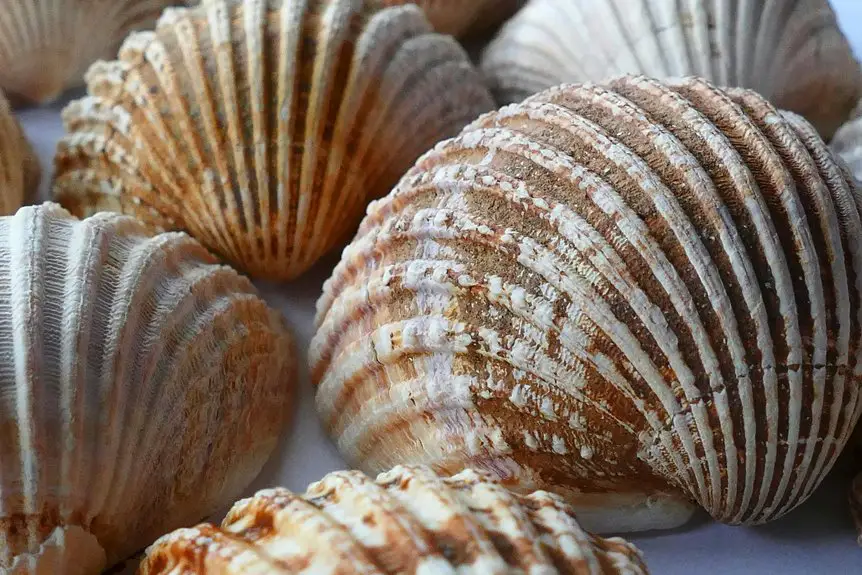When you look at corduroy fabric, those raised vertical lines you see are called “wales.” They’re created by extra fibers woven into the fabric and then cut to stand upright, giving corduroy its unique texture and softness. The width and number of these wales can vary, affecting how the fabric looks and feels. Understanding wales helps you appreciate corduroy’s durability and style, with more details waiting as you explore further.
Table of Contents
Key Takeaways
- The raised lines on corduroy fabric are called “wales,” running vertically along the textile.
- The flat spaces between the wales are known as “channels.”
- Wale count per inch determines the fabric’s texture, with terms like “wide wale” or “pinwale” describing ridge thickness.
- Wale ridges are formed by cut pile yarns standing up from the fabric base.
- These ridges provide corduroy its softness, warmth, durability, and distinctive appearance.
The Origin of Corduroy Fabric
Although corduroy’s exact beginnings are unclear, you’ll find that this durable fabric dates back several centuries. You might be surprised to learn that early versions appeared in Europe and Asia, where people valued its strength and warmth.
When you wear corduroy, you’re embracing a textile designed for practicality, originally favored by workers and outdoorsmen. Over time, it moved beyond utility, becoming popular in fashion circles. You’ll notice that corduroy’s unique look set it apart from other fabrics early on.
As you explore its history, you’ll see how it evolved through innovations in weaving and finishing techniques. By understanding its origin, you appreciate why corduroy remains a beloved fabric today, offering both style and resilience.
Defining the Ridges on Corduroy
You’ll want to get familiar with the specific terms used for corduroy ridges to fully appreciate the fabric’s design.
Understanding how these ridges are structured reveals why corduroy feels so unique.
Plus, knowing their function helps you see why corduroy remains popular across different styles.
Corduroy Ridge Terminology
Many people confuse the different parts of corduroy ridges, but understanding their terminology helps you identify and describe them accurately.
The raised lines you see are called “wales.” These wales run vertically along the fabric and are the defining feature of corduroy. Between each wale lies a flat area known as the “channel.”
When you touch the fabric, you feel the texture of the wales, which are created by cut pile yarns standing up. The thickness or number of wales per inch varies, and you might hear terms like “wide wale” or “pinwale” referring to this.
Knowing these terms lets you describe corduroy with confidence, whether you’re shopping, sewing, or simply appreciating the fabric’s unique look.
Structure of Corduroy Fabric
The structure of corduroy fabric relies on its distinctive ridges, which give it both texture and character. When you look closely, you’ll see these ridges are called “wales”—raised cords formed by extra sets of fibers woven into the base fabric.
The fabric starts with a plain woven foundation, then additional threads are inserted to create the vertical ribs. After weaving, the fabric undergoes a cutting process that lifts the pile, forming those soft, raised lines you recognize as ridges.
The number of wales per inch varies, affecting the fabric’s appearance and feel. This layered construction, with its dense, tufted ridges, is what sets corduroy apart from other textiles, making it unique both visually and texturally.
Function of Corduroy Ridges
Because corduroy ridges create both texture and depth, they play an essential role in how the fabric performs and feels.
When you run your hand across corduroy, those raised ridges, called wales, give the fabric its unique softness and warmth. They trap air, providing insulation that keeps you cozy in cooler weather.
The ridges also add durability by protecting the base fabric underneath from wear and tear. Plus, they influence the garment’s flexibility, allowing it to stretch slightly while maintaining shape.
You’ll notice that the width and spacing of these ridges affect the overall look and feel, making corduroy versatile for different styles.
Understanding their function helps you appreciate why corduroy remains a popular, practical fabric choice.
What Are Corduroy Ridges Called?
You might wonder what those raised lines on corduroy fabric are officially called.
They’re known as “wales,” which refers to the vertical ridges that give corduroy its texture.
Sometimes, people also call them ribs or cords, but wales is the most accurate term.
Definition of Corduroy Ridges
Corduroy ridges, often called “corduroy roads,” are a type of primitive pathway made by laying logs perpendicular to the direction of travel.
When you come across corduroy ridges, you’re fundamentally looking at a simple but effective solution to crossing swampy or muddy terrain.
Here’s what defines them:
- Log Placement: Logs are laid side by side across the path, creating a ribbed texture resembling corduroy fabric.
- Purpose: They stabilize soft ground, preventing vehicles or people from sinking into mud.
- Durability: While not smooth, these ridges provide a reliable, temporary roadway in challenging environments.
Alternative Names Explained
Logs laid crosswise to create a ribbed surface are often known by several names depending on the region or context.
You might hear them called “corduroy roads,” especially when referring to old paths built over swampy or muddy terrain. In some areas, people simply say “log roads” or “log causeways.”
If you’re in forestry or construction, terms like “timber mat” or “log mats” might come up, describing portable sections of this ribbed pattern used to protect soft ground.
Sometimes, “corduroy planks” refers to smaller-scale versions. Knowing these alternative names helps you recognize the same basic technique in different settings, whether historical, industrial, or environmental.
How Corduroy Ridges Are Made
Although they might look natural at first glance, corduroy ridges form through a very specific process involving fallen trees. When a swampy or muddy area floods, large trees fall and get trapped in the soft ground.
Over time, sediment covers these logs, preserving their shape. As the water recedes and the soil hardens, these buried logs create the raised ridges you see.
Here’s how it happens:
- Trees fall across wet, marshy terrain, often in groups.
- Sediment and mud accumulate, burying the logs horizontally.
- The organic material decays slowly, leaving behind a pattern of ridges formed by the log trunks.
Understanding this process helps you appreciate the unique landscape corduroy ridges create.
Different Types of Corduroy Ridges
Now that you know how corduroy ridges form, let’s explore the different types you’ll come across.
You’ll see these ridges classified by their formation, and notice variations in their patterns.
Plus, we’ll look at some real-world examples to help you recognize each type.
Classification by Formation
When you examine corduroy ridges, you’ll notice they form through several distinct processes that shape their unique patterns.
Understanding these formation types helps you identify how different ridges develop over time. Here are the main classifications by formation:
- Glacial Deposition Ridges – These ridges form when glaciers deposit debris in parallel lines as they advance or retreat.
- Fluvial Erosion Ridges – Created by river or stream erosion, these ridges appear when water cuts into the landscape, leaving raised linear features.
- Periglacial Frost Heave Ridges – Formed in cold climates, frost heaving pushes soil and rocks into ridges, creating distinctive corduroy-like patterns.
Variations in Ridge Patterns
Corduroy ridges showcase a variety of patterns that reflect the forces shaping them. When you observe these ridges, you’ll notice differences in spacing, height, and alignment. Some ridges run parallel with uniform gaps, while others curve or intersect due to shifts in glacier movement.
The size of individual ridges can also vary, influenced by the sediment type and the glacier’s pressure. You might find tightly packed ridges in areas with consistent ice flow or more irregular patterns where the glacier’s speed fluctuated.
Examples of Corduroy Ridges
Although these ridges share common features, you’ll find several distinct types of corduroy ridges formed by varying glacial conditions. Understanding these examples can help you identify corduroy ridges in different landscapes.
- Subglacial Corduroy Ridges – Formed beneath glaciers, these ridges develop as ice drags sediment over uneven bedrock, creating parallel ridges aligned with ice flow.
- Proglacial Corduroy Ridges – These appear in front of retreating glaciers where meltwater deposits sediment in linear patterns, often more irregular than subglacial types.
- Post-Glacial Corduroy Ridges – Created after glaciers melt, these ridges result from erosion and sediment redistribution, often preserving older glacial ridges beneath newer deposits.
The Role of Ridges in Corduroy’s Texture
Ridges give corduroy its unmistakable feel and appearance, shaping both its texture and character. When you run your fingers over corduroy, those raised ridges—called wales—create a tactile contrast against the smoother base fabric.
This unique texture not only makes corduroy visually distinct but also offers a soft, plush sensation that you’ll notice immediately. The ridges catch light differently, producing subtle shading that adds depth and richness to the fabric’s look.
Because the wales vary in width and spacing, you can find corduroy textures ranging from fine and delicate to bold and rugged. Understanding this helps you appreciate why corduroy feels so inviting and distinctive, making it a popular choice for comfortable, stylish clothing and upholstery alike.
Corduroy Ridges and Their Impact on Durability
The raised wales you feel on corduroy don’t just shape its look and texture—they also play a big role in how long the fabric lasts.
The raised wales on corduroy define its unique texture and significantly enhance its durability.
When you choose corduroy, those ridges add durability in several ways:
- Wear Resistance: The ridges create extra thickness, helping the fabric resist abrasion and everyday wear.
- Structural Strength: The woven pile structure reinforces the fabric, making it less prone to tearing under stress.
- Stain and Dirt Protection: Dirt often settles between the ridges, allowing you to clean the surface without damaging the fibers beneath.
Fashion Trends Featuring Corduroy Ridges
When you spot corduroy in fashion, those distinctive ridges often steal the show by adding texture and depth to garments.
You’ll find corduroy making a bold comeback in everything from jackets and pants to skirts and accessories. Its unique ridges give outfits a retro vibe while keeping them cozy and stylish.
You can easily pair corduroy pieces with modern fabrics for a fresh, layered look that works well year-round. Plus, the variety in wale sizes—from fine to wide ridges—lets you choose how subtle or striking your outfit appears.
Whether you’re dressing up for a casual day out or aiming for a vintage-inspired ensemble, corduroy’s textured ridges help your style stand out effortlessly.
Caring for Corduroy to Preserve Its Ridges
Although corduroy’s ridges add charm and texture to your garments, they require careful care to keep looking their best.
To preserve those distinctive ridges, you need to handle your corduroy with a few key practices in mind.
- Wash gently: Use cold water and a gentle cycle or hand wash to prevent crushing the ridges. Avoid harsh detergents that can damage the fabric fibers.
- Dry properly: Air dry your corduroy flat or hang it to retain the pile’s height. Avoid the dryer, which can flatten and wear out the ridges quickly.
- Brush regularly: Use a soft-bristled brush to gently lift the pile and remove dirt, keeping the ridges crisp and vibrant over time.
Comparing Corduroy Ridges to Other Fabric Textures
Taking good care of corduroy helps maintain its unique ridges, but understanding how these ridges compare to other fabric textures can deepen your appreciation for this material.
Corduroy’s ridges, or “wales,” stand out because of their distinctive vertical lines formed by cut pile yarns. Unlike velvet, which has a smooth, even surface, corduroy’s texture is more structured and tactile.
Compared to ribbed knits, which have softer, stretchier ribs, corduroy ridges are firmer and more durable. If you’ve touched seersucker, you’ll notice its puckered texture is irregular, while corduroy offers consistent ridges throughout.
Recognizing these differences helps you grasp why corduroy feels so unique and makes it a versatile fabric choice for both comfort and style.
Frequently Asked Questions
Can Corduroy Ridges Affect the Fabric’s Breathability?
Breathability matters, and yes, corduroy ridges do affect it. Since those raised ridges trap air, you’ll notice less airflow compared to smoother fabrics, making corduroy warmer but slightly less breathable overall.
Are Corduroy Ridges Prone to Fading in Sunlight?
Yes, corduroy ridges can fade in sunlight because they’re made of dyed fabric. You’ll want to avoid prolonged sun exposure to keep colors vibrant and prevent those distinctive ridges from losing their rich appearance over time.
How Do Corduroy Ridges Influence Fabric Weight?
You’ll find corduroy ridges add extra fabric thickness, increasing the overall weight. Those raised cords make the material denser and heavier, which gives corduroy its sturdy, warm feel compared to smoother fabrics.
Can Corduroy Ridges Cause Skin Irritation?
Did you know 15% of people report fabric-related skin irritation? Yes, corduroy ridges can cause irritation, especially if you have sensitive skin or allergies. You’ll want to choose softer, high-quality corduroy to avoid discomfort.
Is Corduroy Suitable for Upholstery Due to Its Ridges?
You’ll find corduroy suitable for upholstery because its ridges add texture and durability. However, those ridges might attract more dust and show wear faster, so you’ll need to maintain it regularly to keep it looking great.
- Does Chiffon Fabric Stink - July 15, 2025
- Does Chiffon Fabric Affect the Economy - July 15, 2025
- Does Cotton Fabric Have a Nap - July 15, 2025







